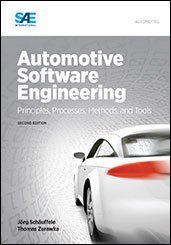Technical Paper
eFMI (FMI for Embedded Systems) in AUTOSAR for Next Generation Automotive Software Development
2021-09-22
2021-26-0048
Nowadays automobiles are getting smart and there is a growing need for the physical behavior to become part of its software. This behavior can be described in a compact form by differential equations obtained from modeling and simulation tools. In the offline simulation domain the Functional Mockup Interface (FMI) [3], a popular standard today supported by many tools, allows to integrate a model with solver (Co-Simulation FMU) into another simulation environment. These models cannot be directly integrated into embedded automotive software due to special restrictions with respect to hard real-time constraints and MISRA compliance. Another architectural restriction is organizing software components according to the AUTOSAR standard which is typically not supported by the physical modeling tools. On the other hand AUTOSAR generating tools do not have the required advanced symbolic and numerical features to process differential equations.

